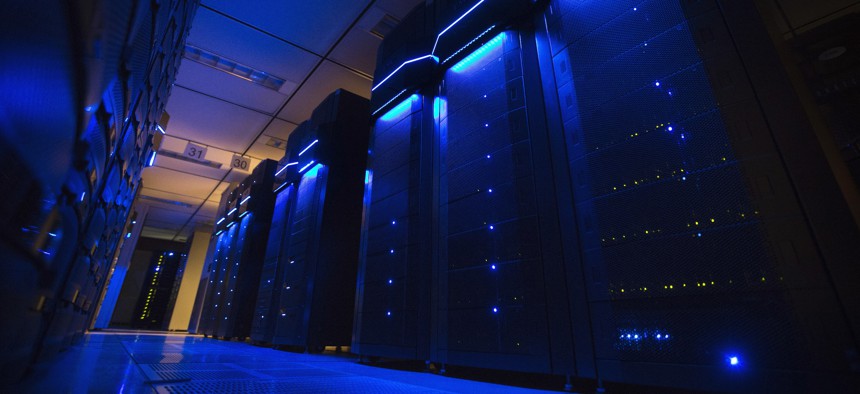
This Wednesday, May 20, 2015 photo shows server banks inside a data center at AEP headquarters in Columbus, Ohio. AP Photo/John Minchillo
The US Must Prepare for a Cyber 'Day After'
The government needs a continuity plan to ensure that critical data and technology remains available after a devastating network attack.
Stealing personal data is not the worst thing that can happen in cyberspace. For years, the U.S. government has warned that foreign nations have been hacking our critical infrastructure and inserting malware that could sabotage dams, pipelines, water supplies, or even transportation systems. Three years ago, an Iranian state-sponsored hacker was indicted for hacking a dam in New York State.
In its 2019 Worldwide Threat Assessment, the Office of the Director of National Intelligence warned that China has the ability to cause “localized, temporarily disruptive effects” on corporate networks, while Russia “is mapping our critical infrastructure with the long-term goal of being able to cause substantial damage.” And recent news reports indicate that the U.S. has similarly embedded malware into the Russian power grid, pointing digital missiles back at Moscow.
During the height of the Cold War, the U.S. government had plans for the “day after” a massive nuclear strike: how to assure continuity of the government, how to get transportation and communications back online, even how to put hard currency back into circulation and begin regenerating the economy. We currently have no such reconstitution plans for a cataclysmic cyber event.
Part of the problem is the distraction of attention and resources by the daily drumbeat of data breaches and theft of personal data. Data breaches are notorious and widespread, and garner headlines. But they do not present the most dire cyber threat to nations’ economies. Rather, the attacks that could damage or destroy the very foundation of what makes our economy – and our lives—run must concentrate the minds of U.S. policymakers.
Related podcast:
Such disruptive cyber incidents are growing in number and intensity. In summer 2017, the malware “NotPetya” disrupted operations across industry giants such as Maersk, FedEx, and Merck. In March, electrical grid operations across parts of Southern California and Utah were interrupted through a distributed-denial-of-service attack. That same month, hackers forced Norsk Hydro, one of the world’s largest manufacturers of aluminum, to halt production at some plants and switch others to manual operation.
Related: Suspected Iranian Cyber Attacks Show No Sign of Slowing
Related: Cyber Threats Are Emerging Faster Than DHS Can Identify and Confront Them
Related: Pentagon Researchers Test 'Worst-Case Scenario' Attack on US Power Grid
Our nation must be able to rapidly reconstitute the infrastructure most important to sustaining the economy. During the Cold War, the United States developed Continuity of Operations/Continuity of Government plans to ensure that the government could reconstitute and perform a minimum set of essential public functions after a nuclear attack. But today’s risks extend beyond direct threats to the U.S. government, and the resources needed to mitigate them far exceed government capabilities. In fact, most capabilities to recover from a large cyber-enabled economic warfare attack reside in the private sector. Yet these capabilities are usually focused on helping specific sectors or, more specifically, individual corporations, rather than the national economic infrastructure as a whole.
The U.S. government should institute a Continuity of the Economy, or COTE, plan to ensure that the critical data and technology would be available, with priority for critical functions across corporations and industry sectors, to get the economy back up and running after a catastrophic cyberattack. Planners must figure out what “seed data” would need to be preserved in a protected and verified format, with a process to assure no corruption or manipulation.
This is different than the standard system back-ups many corporations use in case their data is lost or corrupted. This would go beyond any one company or industry. One helpful model is the financial sector’s Sheltered Harbor in which banks store a copy of their data in standard format in secure data vaults that can be quickly accessed to deny a ransomware attack from crippling a bank. But Sheltered Harbor addresses a very different problem than cold-starting a power grid, assuring safe insulin production and distribution, or rebooting telecommunications networks. COTE will require an approach beyond “stockpiling.” It must focus on functional interaction among specific infrastructure sectors – how electricity supports telecommunications, which supports transportation, which supports oil and gas, which feeds the electricity grid, etc. – and how these interactions directly support key functions of the economy.
For the government to take this approach, it needs to answer some first-order questions: what are the key functions of the U.S. economy that rely on an operational Internet? What are the industrial processes, sectors, and entities that directly support those functions? What data is central to those processes, sectors, and entities, and how long can that data be unavailable before it causes unacceptable and irreversible damage to the economy? What level of damage is unacceptable? And, finally, what scenarios would produce such devastating effects? Answering these questions would yield a more “whole-of-economy” approach than the current stove-piped method of resiliency planning, where risk analysis is still focused on industry sectors rather than cross-sector analysis.
Across the economy, critical entities rely on, in large part, the same set of cloud providers, hardware suppliers, and distribution methods. In a catastrophe, the government will need to prioritize which sectors, and perhaps which companies within those sectors, get limited services and resources first. This would require selectivity within sectors based on interconnectedness and substitutability, and some hard choices on which companies are included in the plan, and which are not.
COTE must be created before the lights go out. Not the day after.
The views and opinions contained herein are solely those of the author, and do not reflect the policies of her affiliations, past or present.